#The Merry Family by Jan Steen
Explore tagged Tumblr posts
Text
Art, symbolism, and storytelling #writing
I love looking at visual art. Viewing paintings and photographs offers us a glimpse of a moment in time that may have occurred centuries ago or may not have occurred at all. Regardless, that moment is frozen and will never change. But I’m a writer. Paintings always show me a story with a past and a possible future. I’m not educated as an art historian and would never claim to be one. I’m just a…
#art and writing#Guernica by Picasso#symbolism in writing#The Merry Family by Jan Steen#writing prompts
1 note
·
View note
Text
Jan Steen (Dutch, 1625/1626–1679) • The Merry Family • 1668 • Rijksmuseum Amsterdam

0 notes
Text

Jan Steen (Dutch, 1625/1626–1679) • The Merry Family • 1668 • Rijksmuseum Amsterdam
On the surface glance, this painting appears to depict a family group making merry at a table. If you look more closely, you'll notice that the young boy at the window is smoking a pipe and the girl standing is pouring wine for her sibling. The paper in the right upper corner reads "So de ouden songen, so pijpen de jongen" (As the old sing, so shall the young twitter.)
Steen painted several of these genre scenes which were fun and lively but carried the moral message about what can happen to the children when their caregivers are ignoring them and pursuing their own pleasures.
#art#painting#fine art#art history#jan steen#dutch artist#baroque art#dutch golden age#17th century european art#genre painting#oil painting#rijksmuseum#museum aesthetic#the painted room art blog#art blogs on tumblr#art lovers on tumblr
32 notes
·
View notes
Text
Hidden Gems of the Rijksmuseum: Uncovering Lesser-Known Treasures
The Rijksmuseum tours in Amsterdam is renowned for its vast collection of art and historical artifacts, and while many visitors flock to see its most famous works, there are numerous lesser-known treasures that deserve recognition. Here are some hidden gems you should uncover when visiting the Rijksmuseum tickets:
"The Merry Family" by Jan Havickszoon Steen: This charming and lively painting by Jan Havickszoon Steen offers a glimpse into the daily life of a Dutch family. It's a delightful, genre scene filled with details that tell a story within the painting.
"The Night Watch" by Rembrandt (Nachtwacht): While not entirely a hidden gem, this masterpiece by Rembrandt often overshadows other works in the museum. Pay close attention to the characters and their individual expressions; it's an intricate work of art that reveals more with every viewing.
"The Windmill at Wijk bij Duurstede" by Jacob van Ruisdael: This landscape painting showcases the Dutch countryside and the dramatic effects of wind and light. It's a beautiful example of Dutch Golden Age painting.
"The Wardens of the Amsterdam Drapers' Guild, Known as 'The Syndics'" by Rembrandt: This striking portrait of five men who served as guardians for the drapers' guild is a testament to Rembrandt's exceptional skill in capturing the personalities of his subjects.
"The Threatened Swan" by Jan Asselijn: This dramatic painting of a swan defending its nest is a powerful depiction of the protective instinct in nature. The swan's outstretched wings and the looming threat add intensity to the scene.
"The Meagre Company" by Frans Hals: Frans Hals was a master of capturing lively and animated group portraits. "The Meagre Company" showcases his talent, with a group of militiamen engaged in a toast and conversation.
"The Jewish Bride" by Rembrandt: While Rembrandt's "Night Watch" gets most of the attention, "The Jewish Bride" is an intimate and emotionally rich portrait that's well worth your time.
"The Threatened Swan" by Jan Asselijn: This dramatic painting depicts a swan defending its nest, and the tense atmosphere makes it a captivating work of art.
"The Milkmaid" by Johannes Vermeer: While not entirely hidden, this exquisite Vermeer painting is often overshadowed by other works in the museum. It captures a simple, yet beautiful moment in daily life.
"Marten Soolmans and Oopjen Coppit" by Rembrandt: These life-size, full-length portraits of a wealthy couple are stunning examples of portraiture during the Dutch Golden Age. The meticulous attention to detail and luxurious attire make them stand out.
When you visit the Rijksmuseum, take your time to explore these lesser-known treasures and immerse yourself in the rich history and artistry of the Dutch Golden Age. You'll discover that the museum has much more to offer beyond its most famous pieces.
0 notes
Photo

Merry family, 1668, Jan Steen
Medium: oil
https://www.wikiart.org/en/jan-steen/merry-family-1668
75 notes
·
View notes
Photo

“The Merry Family” by Jan Steen, 1668
1 note
·
View note
Photo

The Merry Family by Jan Steen (1668)
From A dozen eggs for Easter from the Rijksmuseum
7 notes
·
View notes
Photo

The Merry Family by Jan Havicksz. Steen, 1668, Museum of the Netherlands
This boisterous family is making a lot of noise: the father sings at the top of his lungs while raising a glass; the mother and grandmother chime in; and the children are either blowing into a wind instrument or smoking a long pipe. The note hanging from the mantelpiece gives away the moral of the story: ‘As the old sing, so shall the young twitter.’ What will become of the children if their parents set the wrong example?
21 notes
·
View notes
Text
#FineArtFriday: The Merry Family, by Jan Steen (revisited)
Jan Steen was fond of painting peasants and ordinary people, and this picture is a good example of that. What I love about this image is the chaos. Is this a New Year’s party? I hope so. The clutter of pans and dishes heedlessly fallen to the floor, the boisterous enjoyment of wine and song, and the obvious lack of parental restraint is wonderfully depicted. The numerous children are smoking and…

View On WordPress
#17th-century Netherlandish paintings#Art in the age of the Puritans#Renaissance Art#The Merry Family by Jan Steen
0 notes
Photo

Jan Steen, The Merry Family. #FatCatArt office on Friday 😹🍤 🍻 @rijksmuseum #JanSteen #rijksmuseum #paintingoftheday #catpainting #artprint #classicart #classicartmemes #fatcat #bigcat #catsofinstagram #orangecat #gingertabby #gingercat #catlover #catsoftheday #bestmeow
#jansteen#classicartmemes#fatcat#catlover#rijksmuseum#paintingoftheday#classicart#artprint#fatcatart#bigcat#gingertabby#catpainting#catsoftheday#bestmeow#gingercat#orangecat#catsofinstagram
38 notes
·
View notes
Text
Day 186: Last Day in Amsterdam (Rijksmuseum and Sweets. Lots and lots of Sweets.)

Our week in Amsterdam had flown by, and today was our last chance to cross any items off our must-see list. The biggest line item was the Rijksmuseum, the Netherlands' answer to the Louvre in Paris and the National Gallery in London. We also had a canal boat tour to cash in, as well as some more edible works of art to enjoy.

Our first stop of the day came at the recommendation of one of Jessica's friends, who had insisted that we absolutely had to try some Dutch poffertjes from a food cart at the Alberg Cuyp Street Market. A sort of fluffy miniature pancake, poffertjes can be popped out hot and fresh by the dozen thanks to a clever contraption that pours the batter into a specialized pan


We got them with sea salt and caramel sauce, and they were the creamiest, fluffiest, most delicious things we could remember tasting on the entire trip.
As we walked over from the street market to the Rijksmuseum, we stopped for coffee at an espresso bar that one reviewer claimed to be the best in Europe outside of Italy. It was just okay, at best.

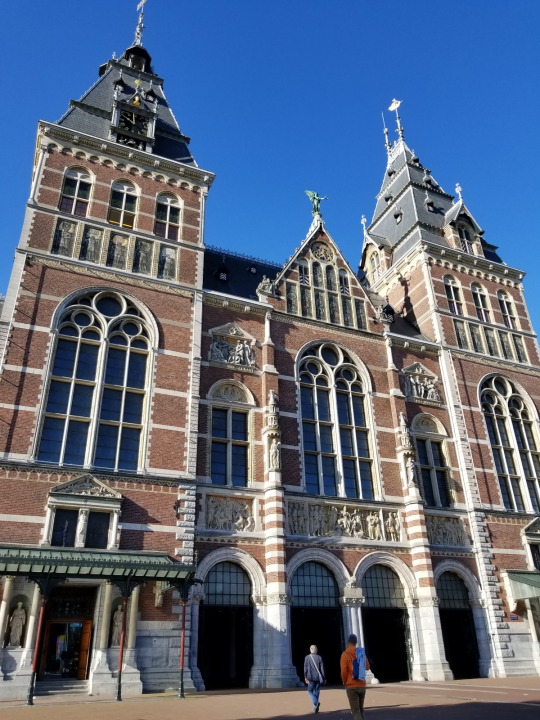
The Rijksmuseum is beautiful and massive. It resembles a cathedral from the front, with its twin spires, tall arched windows, and engraved images---not of saints and martyrs, but of artists and scholars.

Inside, we ran yet again into our old friend Laocoön one last time. Note how in this depiction, Laocoön's right arm is extended horizontally outward instead of bent back at the elbow. As we'd learned back in the Vatican archives, that means that this statue (or possibly the copy that it was a copy of) was made before 1906, when the original statue's missing right arm was finally discovered. Before then, most experts believed that Laocoön's arm had been extended in the way we see here. Given the aesthetic principles of Greek and Roman sculpture, it seemed obvious.
But Michelangelo had known better.
Four hundred years earlier, when tasked by the Vatican to reassemble the recently unearthed statue, Michelangelo could tell that the right arm was supposed to be bent. Just by looking at the musculature of the one-armed statue, he deduced that, 1) the original Greek sculptor was as much a master of human anatomy as he was himself, and 2) that the way the muscles in the sculpture's back were flexed meant that the model posing for the statue had to have had his arm bent back at the elbow. And he was right. It's like something out of Sherlock.
Bypassing the rest of the museum for now, we headed straight upstairs to the main event: the Gallery of Honor, a purpose-built grand hall exhibiting the best of the best of the Dutch Golden Age.
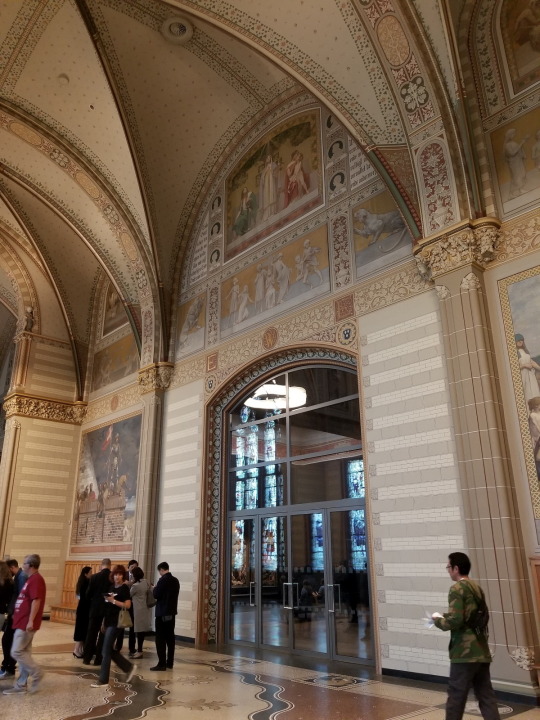


The museum's cathedralesque motif resumed at the top of the stairs. Light poured into the gallery's antechamber through stained glass windows venerating the great artists and thinkers of Western civilization.

The Rijksmuseum's Gallery of Honor is a brilliant idea that I think more museums should embrace. It consists of a long, vaulted corridor lined with alcoves dedicated to the greatest works of the greatest Dutch artists from the Golden Age. Even if you only had one hour to visit the museum, you could spend the entire hour here and leave contented that you made good use of your time.
The previous day, we'd been so impressed by the Mauritshuis in The Hague for its impressively manageable collection. In a way, the Gallery of Honor does an admirable job of creating the same effect in a much larger museum---it makes the unmanageable manageable.
Rather than rushing around trying to see all the most important stuff---our visit to the Louvre in a nutshell---the Rijksmuseum brings all the most important stuff to you in one easy room. Then, if you have more time, you can relax and explore the rest of the museum's fantastic collections at your leisure, free to guiltlessly explore whichever exhibits happen to tickle your curiosity.
But enough about design theory; let's get to the art.

One of our favorite artists featured in the room was Jan Steen. A natural comedian and storyteller among the Golden Age artists, Steen made paintings that were colorful, fun, and lowbrow with a snarky undercurrent of social commentary.
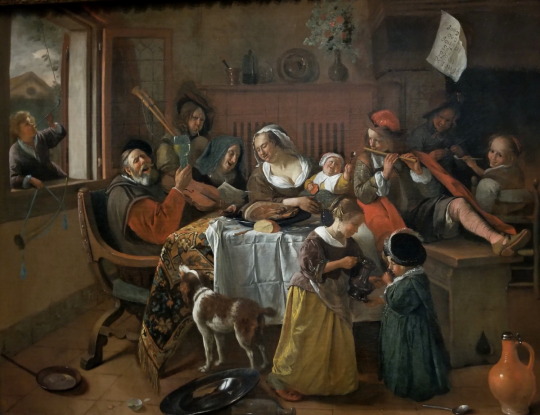

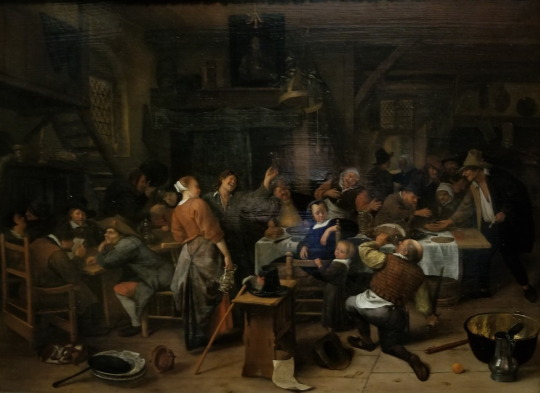
Many of Steen's paintings feature large families or groups of revelers, and the level of detail is amazing. His faces are brilliantly emotive, and every person exudes a sense of story. One of my favorites is Prince's Day, which shows a raucous tavern scene. There are over twenty characters in the picture, and every one of them feels fully alive and engaged with what's happening---even the barely visible couple whispering to each other in the background.
But the real punchline is a barely-there portrait of the prince hanging in the murky recesses of the ceiling. These people couldn't care less that they're supposedly celebrating the prince's birthday; they're just happy for any excuse to drink and be merry. And the primly dressed little girl looking straight out at you from the middle of the scene seems to know it, too.
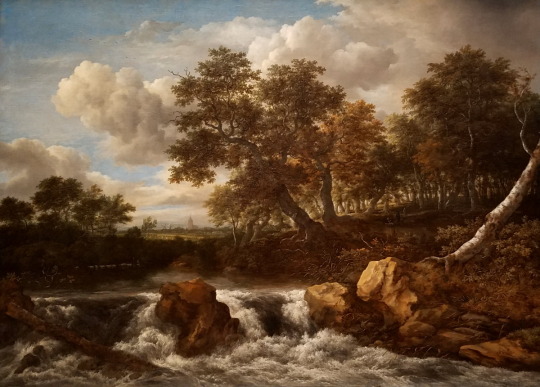

It's no surprise that Jessica and I both loved the work of Van Ruisdael, the Golden Age's master landscape artist. I was particularly struck by his painting of The Windmill at Wijk bij Duurstede. It shows a picturesque windmill standing near a river. The nearby town is just discernible by the roofs of the local church and castle peeking up in the distance. Late afternoon sunlight beautifully illuminates the windmill at a dramatic angle, and at first the scene seems idyllic. Looking closer, however, you can see the clouds are becoming ominously dark, and the surface of the river is marked by a noticeable chop.
I may be overthinking it, but with the way the windmill dominates the scene while the castle and church fade into the background, it seems as though Ruisdael had something to say about the relative positions of industry, government, and religion in Golden Age Dutch society. Perhaps even about which way the winds were blowing, so to speak.


Another of the honored greats was Frans Hals, with his ability to create portraits that are remarkably heartwarming and instantly likeable.
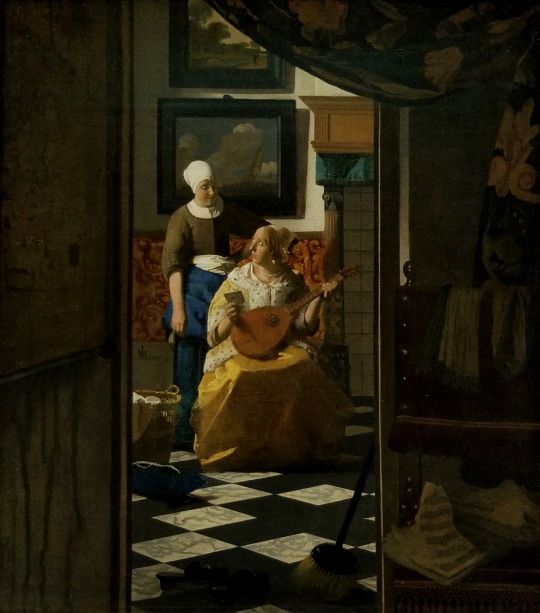

And of course, there was Vermeer---the once-nearly-forgotten master of light and color whose slow and fastidious technique (along with his relatively early death) left him with remarkably few paintings to his name. As we'd learned the day before at the Mauritshuis, the Rijksmuseum has the largest collection of paintings by Vermeer in the world: four. And while the Mauritshuis has the iconic Girl With a Pearl Earring, the Rijksmuseum has some classics, too, including The Love Letter, The Milkmaid, and Woman Reading a Letter.

At least, usually. When we visited, however, Woman Reading a Letter was on loan to the Alte Pinakothek in Munich. Luckily, Jessica and I had already been there and seen that.

Another particularly interesting canvas came in the unlikely form of an angrily defecating swan. The life-size Threatened Swan was painted by Jan Asselijn as a straightforward nature scene, showing the drama of a swan defending its nest from a curious dog. But that's just the beginning of its story.
Over a hundred years later, simple nature paintings had gone out of style. People wanted art to be rich with symbolism---whether or not the artist actually intended it. The Threatened Swan was therefore "improved" by the addition of allegorical labels, effectively turning it into a glorified nationalist political cartoon. The swan's eggs were labelled "Holland," the dog was labelled "enemies of the state," and the swan was the Dutch government defending the people of Holland from their enemies.

Last but not least was Rembrandt, the big daddy of the Golden Age painters. Rembrandt was a master of pretty much every genre of painting, but his trademark was large-scale group portraits. It was a mark of pride during the Golden Age for professional organizations to commission group portraits of their members. And Rembrandt had a unique talent for turning what would normally have been a dull lineup of doctors or lawyers into a lively and interesting scene.

The ultimate room at the end of the Gallery is dedicated to Rembrandt's massive Night Watch. The room was designed specifically to showcase it, and the rest of the Gallery grew from there.
Today, at least, the painting is considered a spectacular masterpiece. But as soon as he finished it, Rembrandt’s group portrait commissions immediately dried up. Whether this was the result of dissatisfaction with the painting or an unfortunate coincidence caused by an economic downturn is a matter of speculation. In any case, this painting represents the high-water mark of Rembrandt's career.
Another funny story about The Night Watch is that the name is a total misnomer. The painting's actual name is the more accurate but less catchy Militia Company of District II under the Command of Captain Frans Banninck Cocq. Due to the improper use of a dark varnish, the image became so dark that people mistook it for a night scene.
It was only in the 1940s that the varnish was finally removed to reveal the truth. And just over a month after we saw it, the Rijksmuseum began a new restoration project that will hopefully reveal even more lost details. The painting is still on display, though---it is being worked on in public, behind a glass wall that has taken over the center of the room. You can even livestream it on the Rijksmuseum's website.
Having finished our tour of the Gallery of Honor, we were free to wander the rest of the museum to see what we could see.
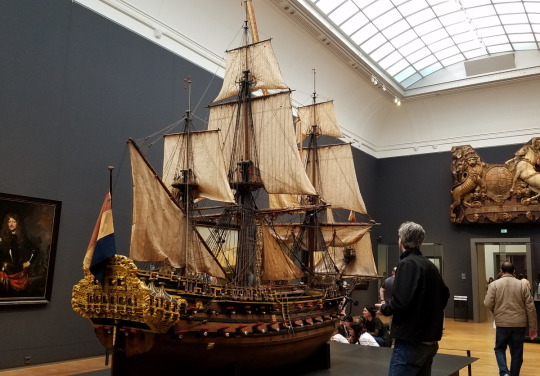
A nearby room on the same floor was dedicated to Dutch naval art and history. Above the door hangs a trophy that we found as hilarious as it was interesting. For everyone else, it will take a bit of explaining.
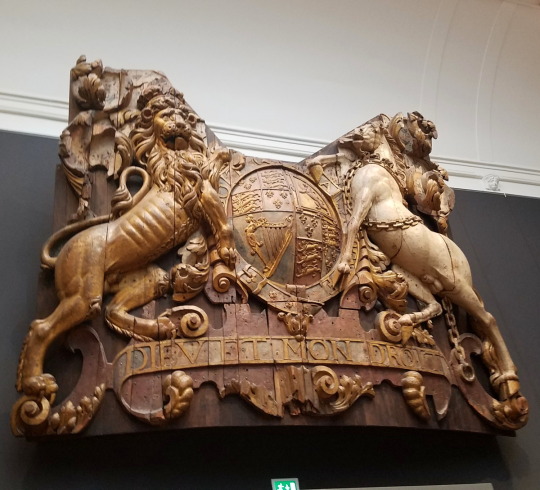
Thanks to our travels in the UK, Jessica and I were able to immediately recognize the emblem on this ship’s stern carving as the British royal crest. So, what was a piece of a royal British ship doing hanging in a Dutch museum? The bulk of the room is dedicated to explaining the story.

In a daring raid, Dutch captain Michiel de Ruyter sailed his fleet up the English River Medway and captured over a dozen English warships, including the English flagship HMS Royal Charles. He towed the Royal Charles back to Amsterdam, where it was put on display as a tourist attraction---to the great annoyance of its namesake King Charles II of England.
The ship was eventually broken up for scrap, and this stern piece was kept as a trophy of the catastrophic embarrassment they had wrought upon the British navy.
That was what Jessica and I found so hilarious.
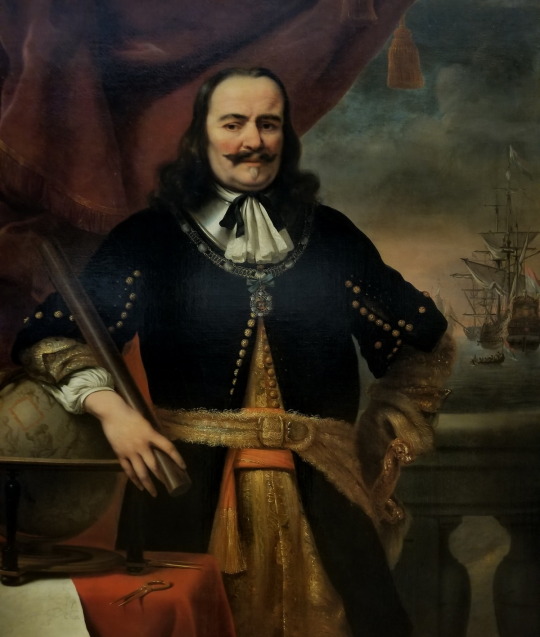


De Ruyter became a national hero in the Netherlands, and even King Louis XIV of France---with whom the Dutch were not on particularly good terms---honored De Ruyter just for sticking it to the English.

Another nearby room was filled with landscape paintings, including one that Jessica and I recognized instantly for its style as the work of our favorite artistic discovery of the trip: Claude Lorrain. A nearby plaque explained that, much like Claude, many of the great Dutch landscape artists honed their skills while studying abroad in Rome.



We also saw some truly insane dollhouses. Apparently, it was popular among a certain class of wealthy Dutch merchants to show off buy commissioning absurdly opulent dollhouses. The houses were incredibly detailed, with miniature recreations of real paintings on the walls. One of these dollhouses on display was as tall as a person and cost more than an actual house in its day.

And of course, once a merchant had spent a considerable fortune on completing their dollhouse, it was only natural for them to then commission an artist to do a painting of it.


One of the larger rooms was dedicated to the famous ceramic pottery made in the Dutch city of Delft.
We learned that the tremendous success of "Delft Blue" pottery industry is partly due to Queen Mary II of England, wife of William of Orange. Mary loved the blue-and-white ceramics that the Dutch were importing from China and Japan. Naturally, this started a craze among well-to-do Dutch and English women who wanted to copy her style. There were only so many imported ceramics to go around, however, so it was only a matter of time before a group of Dutch artisans cracked the secret and began making their own domestic versions.
Delft Blue pottery ended up becoming so renowned that it was even exported back to China and Japan.
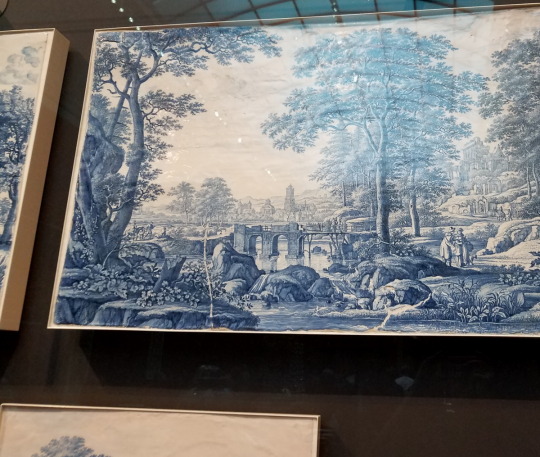
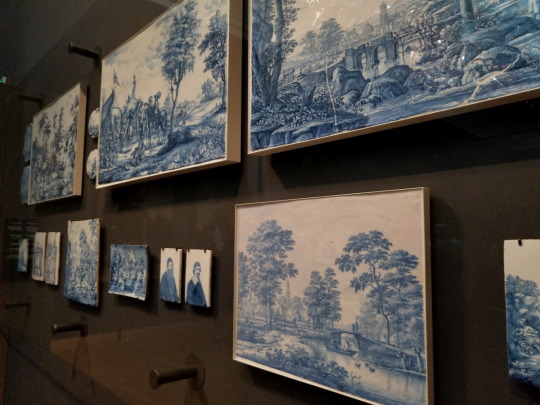
There's even an artistic offshoot dedicated to creating illustrated Delft Blue tiles as an alternative to canvas paintings.


Downstairs, we saw some impressive Post-Impressionist paintings, including self-portraits by Van Gogh and his friend Emile Bernard.

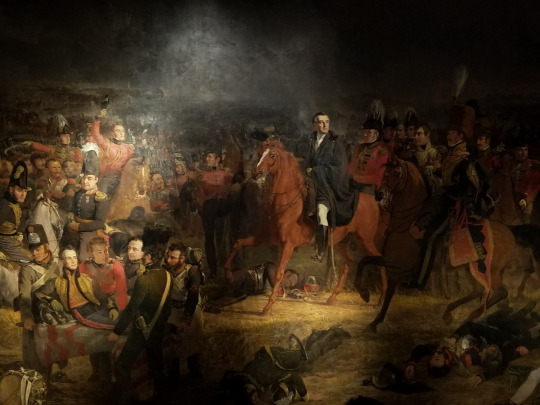
Before leaving the museum, we made sure to see one last highlight of the museum---a massive floor-to-ceiling painting by Jan Willem Pieneman of the victorious Dutch and British forces after the battle of Waterloo. The painting was commissioned by the Duke of Wellington to celebrate his victory, and he can be seen in the center of the painting, illuminated with a shaft of light as if by God. But the Dutch King William I saw the painting and liked it so much that it bought it out from under Wellington and gave it to his son Prince William II. The prince is also featured in the painting, in the lower left corner, being carried off the battlefield on a stretcher.



After leaving the museum, we took another stroll through Vondelpark, which we'd visited before after seeing the Van Gogh Museum. It's a big park, but trees and canals do a nice job of dividing it into cozy-feeling sections where you can almost feel alone with nature.
It was beautiful and serene, except for one mildly horrifying sight we came upon when we had to cross under an overpass.
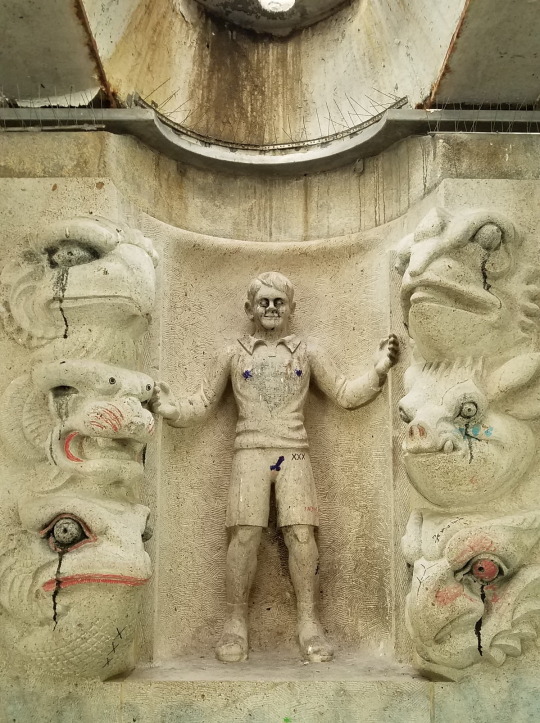
Our next goal of the day was to find some oliebol, a sort of Dutch doughnut hole that Nic was determined to try. We found a highly rated bakery, but we were sadly informed that oliebols are only really made around Christmas. So instead, we made do with some raspberry-redcurrant tarts that were to die for.

(Don’t ask about the potato…)
The tarts had an unusually thick, cookie-like crust. Jessica tried to wheedle the secret out of the man behind the counter, but he either didn’t know or just played dumb.


With nothing better left to do, it was finally time to cash in the canal boat tour vouchers that we'd gotten in a package deal with our Van Gogh Museum tickets and the windmill countryside tour. It's no less touristy than any of the big City Sightseeing bus tours, but we still had fun and learned a bit.


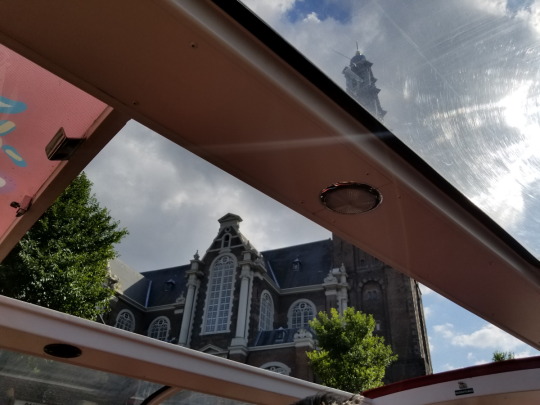
We learned that the three U-shaped canals that belt the center of Amsterdam were dug during the Golden Age, when Amsterdam’s population quadrupled in size and necessitated a major city expansion. The inner ring was for royals and nobility, the middle ring was for wealthy merchants, and the outer ring was for the working class and warehouses.
Today, even the outer ring is such valuable property that only things like banks and high-end boutiques can afford it.
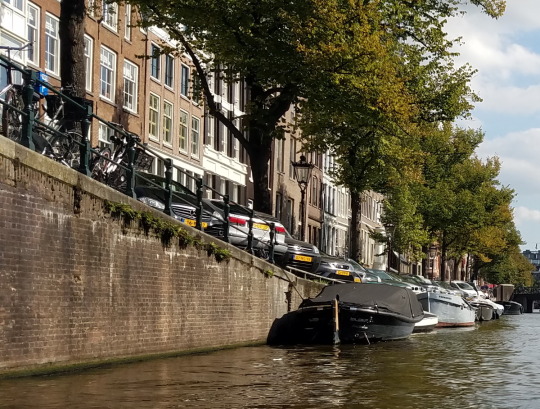
As much as any of the other amazing sights, we were also impressed by how daringly close the drivers of Amsterdam park their cars to the edge of canals.

We also learned the story behind Amsterdam’s city crest---a red shield with a vertical black bar and three white X's (more formally known as crosses of St. Andrew). The red shield symbolizes the city, the black line symbolizes the Amstel river that runs through the city, and the three crosses of St. Andrew represent divine protection from fires, floods, and plagues.
The use of red and black to represent the city and the river seemed odd at first, but as we talked about it after the cruise, we soon realized that we were walking on red brick streets and looking out at a shimmering river that looked like glinting obsidian in the sunlight.


We decided to end the day with a meal at Europe’s oldest floating Chinese restaurant. Another thing we'd learned on the canal tour was that Amsterdam has the oldest Chinatown in continental Europe. (Jessica and I had already learned that Liverpool has the oldest Chinatown in all of Europe.)
Well, we almost ended the day there.
Nicolas wouldn’t be satisfied with our stay in Amsterdam until we'd had some of the churros we’d seen in bakeries and chip shops around town all week.
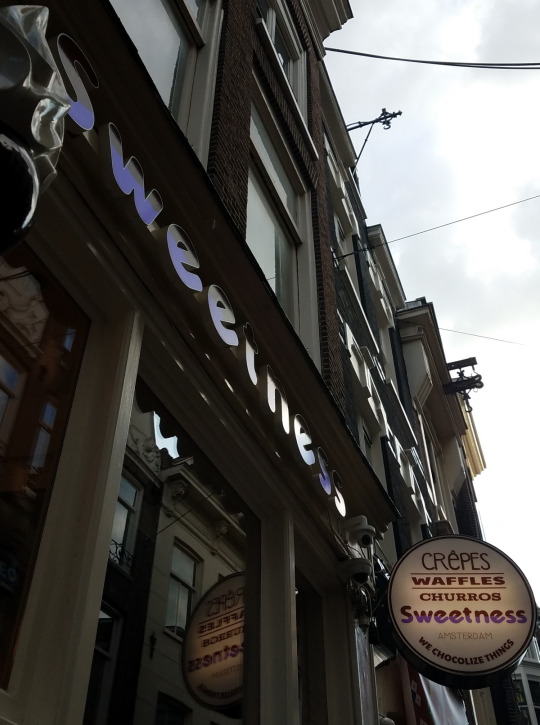
Venturing back into the streets, we found a hole-in-the-wall ice cream joint near the Red Light District called Sweetness. We ducked inside and soon found ourselves ordering something called the Red Light Special, which looked like a sort of churro sundae in the pictures on the overhead menu.
It wasn’t until the server turned out the lights and shouted “Are you ready?!” that we began to wonder whether we had ordered something we hadn’t intended to.

It was a churro and ice cream extravaganza, complete with red sparklers and a powdered-sugar fireball.

As ridiculous as it was, it was also delicious and just the right size for the three of us.

With our stomachs full of sweets, it was finally time for us to head home and start packing up. Tomorrow we would be flying to Iceland for a 48-hour cherry to cap off our six-month adventure. It’s been an amazing ride, and it’s hard to believe it’s already almost over.
#180abroad#amsterdam#netherlands#rijksmuseum#canal cruise#churros in the red light#museum#art#history#travel
0 notes
Text
How does our understanding of social and cultural practices of the past impact how we conduct ourselves socially and professionally in the present?
How does our understanding of social and cultural practices of the past impact how we conduct ourselves socially and professionally in the present?
Art Merry Family by Jan Steen and The Potatoe Eaters by Vincent van Gogh
. Visual and Historical Analysis This section will provide a visual and historical analysis in which you will analyze the physical characteristics in each work as well as the connections of each work to its historical and cultural context. A. What formal characteristics are similar between the two works? What…
View On WordPress
0 notes
Photo

Merry family, 1668, Jan Steen
Medium: oil
21 notes
·
View notes











